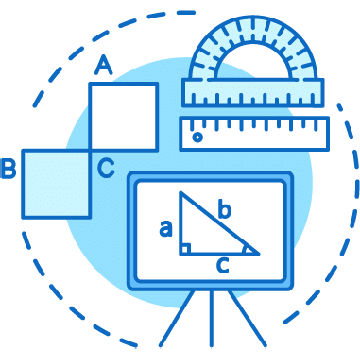Introduction
If you’re a parent or a student, you’ve probably heard terms like “Common Core” and “traditional math” thrown around. These two different approaches to teaching mathematics in K-12 education have been a subject of discussion and debate among educators, parents, and policymakers. While many supporters of traditional math value its historical success, others believe Common Core is a more modern, concept-based approach that helps students better understand why math is important.
Why The Debate?
Math is a foundational skill that shows up in our daily lives, from calculating bills to understanding data and making informed decisions. Various careers, from engineering to finance, require a strong mathematical background. Students who are understand math well can navigate numbers and ideas presented to them in the real world more easily. The debate over the two different approaches often revolves around the effectiveness of each and the best way to prepare students for future success, with standardized testing as the guiding metric. Each approach has its unique features, challenges, and benefits. Understanding these differences can help you choose the path that best suits your learning style or that of your child.
It’s important to note that the terms “Common Core” and “traditional math” can be somewhat broad, and educational practices can vary from one school district to another. Some educators blend elements of both approaches to provide a well-rounded math education.
Common Core Math: Understanding the Approach
The Common Core State Standards Initiative, often simply referred to as Common Core, was introduced in the United States in 2010 with the intention of standardizing and improving education. The set of educational standards for mathematics outlines what students should know and be able to do in math at each grade level. These key standards involve:
1. Emphasizing Conceptual Understanding
Common Core math students truly grasp the underlying mathematical concepts by using methods such as visual representations or hands-on activities. It encourages students to understand why math procedures work rather than relying on simply memorizing. For example, they may explore the concept of place value before learning long division.
2. Critical Thinking and Problem-Solving Skills
Students are challenged to think deeply about mathematical problems, explore multiple paths for a solution, and justify their reasoning so that they become not just calculators but problem-solvers.
3. Real-World Applications
Common Core aims to make mathematics more relevant to students’ lives by connecting math to everyday situations. Students get to understand the practical application of math by working on problems with scenarios that they might encounter outside the classroom. For instance, they might solve problems involving budgeting, data analysis, or geometry in everyday contexts. Common Core focuses on motivating them to engage with the material.
4. Mathematical Progression
The Common Core standards are designed to build upon each other from one grade level to the next, which means that students revisit and learn more about concepts and skills that were introduced to them in earlier grades. For example, they start with geometry in early grades – basic shapes and their properties. They then move on to concepts like angles, symmetry, and area and perimeter, building a solid foundation for more advanced geometry topics like congruence and similarity in later years. This progression gives students a connected understanding of mathematics over the course of their math education rather than discrete math classes that seem to have no direct relation to each other.
5. Increased Depth
Common Core math often covers fewer topics but in greater depth compared to the traditional math approach so that students can master fundamental concepts before moving on to more advanced material.
6. A Focus on Communication
Assessments often include open-ended questions that require students to provide detailed explanations to demonstrate their thought processes. For example, a math question might ask for an explanation of a student’s reasoning when solving a problem or evidence and justification of an answer. Students are expected to communicate both verbally and in writing. This not only reinforces their understanding but also helps teachers assess their thinking and provide targeted support.
7. Assessments Aligned with Standards
Assessments, such as standardized tests, are designed to align with Common Core standards. These assessments evaluate more than just knowledge – students must show how they think through and apply their mathematical knowledge. The aim is to provide a more comprehensive view of a student’s proficiency in math, emphasizing conceptual understanding, problem-solving abilities, and the practical application of math in real-world situations.
While in principle, Common Core is designed to enhance student proficiency in mathematics, its actual implementation has faced challenges. Among educators, parents, and students, some of the drawbacks include:
- Complexity and Confusion: Some students, parents, and even educators have criticized the complexity of Common Core math standards. Problems that usually would only need a single answer might focus too much on the “why” instead.
- Lack of Flexibility: As with any approach with “standards,” the focus on test preparation may limit teachers’ flexibility in adapting instruction to the needs of their students. Sometimes, a one-size-fits-all approach may not consider the diverse learning styles and abilities of students.
- Implementation Challenges: Implementing Common Core standards is an overhaul of the existing education system. The quality of a student’s experience with this “new math” depends on the quality of teacher training and instructional material. For some states, teachers have had difficulties in developing a full curriculum while trying to implement the standards as quickly as possible.
- Parental Opposition: Some parents with more experience in traditional math methods feel that the new methods make it harder for them to assist their children with math homework.
Traditional Math: A Familiar Approach
The traditional approach to teaching mathematics has been the cornerstone of math education for generations. Historically, the way math has been taught involves:
1. Procedural Fluency
Traditional math education places a strong focus on specific algorithms and procedures for solving math problems. For example, students learn long division, multiplication, and addition algorithms and are expected to apply them systematically. It can be easier for some students to follow and understand a clear and structured way of tackling problems.
2. Memorization of Facts and Formulas
Students often have to rely on memorization. For example, they must commit multiplication tables, mathematical formulas, and various mathematical rules to memory. Having these rules memorized almost to heart allows students to swiftly and accurately solve problems later on.
3. Standardized Methods
A methodical and step-by-step approach to solving equations and mathematical operations instills discipline and precision and gives students a structured framework to follow.
4. Repetition and Practice
Students are presented with numerous exercises and problems to solve to reinforce their skills and ensure that they can consistently apply procedures in any situation.
5. Breadth of Topics Covered
Traditional math typically covers a broad spectrum of mathematical topics. Students are exposed to various concepts and equipped with a comprehensive overview of the field of math.
6. Historical Context
The traditional approach to math education has been the predominant method for many decades. This time-tested way of teaching math has produced generations of mathematically competent individuals. And why fix what isn’t broken?

Although the traditional approach is structured and familiar, critics argue that emphasizes more procedural knowledge than an ability to problem-solve. The problem is that it may not fully prepare students for the demands of the modern world, where success relies applying knowledge in different contexts and situations, which requires a deep understanding of concepts.
- Lack of Conceptual Understanding: Traditional math classes teach students how to perform mathematical operations proficiently, but people say rote memorization isn’t enough to succeed. Often times, students can easily perform calculations with enough practice but still struggle to explain the how mathematical concepts work.
- Limited Problem-Solving Skills: Another component of success is the ability to think critically and problem-solve no matter the situation. Critics believe that with traditional math, students learn only how to follow established procedures and neglect to explore different approaches on their own.
- Real-World Relevance: Students who feel forced to take math often ask, “when will we ever use the tangent ratio or [insert some other math term]?” Students may not see the practical value of what they’re learning because of traditional math problems that involve only numbers without any real-world applications to help cement the concept in their minds.
- Engagement Issues: Some students may find traditional math instruction repetitive and uninteresting, which affects their motivation and enthusiasm for the subject.
Balancing Act: Blending Common Core and Traditional Math
One of the challenges in the math education world is finding the right balance between the depth emphasized by Common Core and the systematic methods typically associated with Traditional Math. Some educators strike this balance by:
1. Incorporating Real-World Applications
Educators can integrate real-world math problems into their teaching to help students see how heavily involved math and their regular lives are. This approach bridges the gap between theory and application and makes math more engaging and relatable.
Example: In a geometry lesson, students explore the practical applications of angles by designing and building structures, such as bridges or towers, using geometric principles.
2. Providing a Solid Procedural Foundation
To address concerns about students’ procedural fluency, educators can ensure that students have a strong foundation in essential math techniques by incorporating focused practice sessions into the curriculum.
Example: Traditional math like weekly timed drills on multiplication tables and division facts can help students build good habits while gaining conceptual understanding in Common Core classes.
3. Personalized Learning
Educators can implement personalized learning strategies since students have diverse learning styles and paces. Math instruction that is tailored to individual student needs allows students to progress at their own rates.
Example: Using adaptive learning software that adjusts the difficulty of math problems based on a student’s performance can provide a personalized learning experience. In fact, the new digital SAT uses this to give students different questions depending on their performance.
Conclusion
Common Core math represents a significant departure from the traditional approach to teaching mathematics with the goal of giving students a deeper understanding of mathematical concepts and the ability to apply math in real-life scenarios. While it has garnered both praise and criticism, it continues to shape mathematics education in the United States, prompting ongoing discussions about its effectiveness and implementation.
Educators can harness the strengths of both Common Core and traditional math to create a balanced curriculum that fosters conceptual understanding, procedural knowledge, and real-world problem-solving skills. By striking the right equation, educators can better prepare students for academic success and future challenges in the ever-evolving landscape of mathematics education.
SEE ALSO: AP Precalculus: Should You Take It?

Yuki is a skilled educator with a degree in Chemistry from Carnegie Mellon University. She discovered her passion for teaching math after tutoring at an after-school program. With five years of tutoring experience, Yuki creates a supportive learning environment for students. Outside of tutoring, she enjoys trying new cuisines and playing piano.
